Affiliate links on Android Authority may earn us a commission. Learn more.
OnePlus 10 Pro vs iPhone 13 Pro: Which one should you buy?
Published onApril 3, 2022
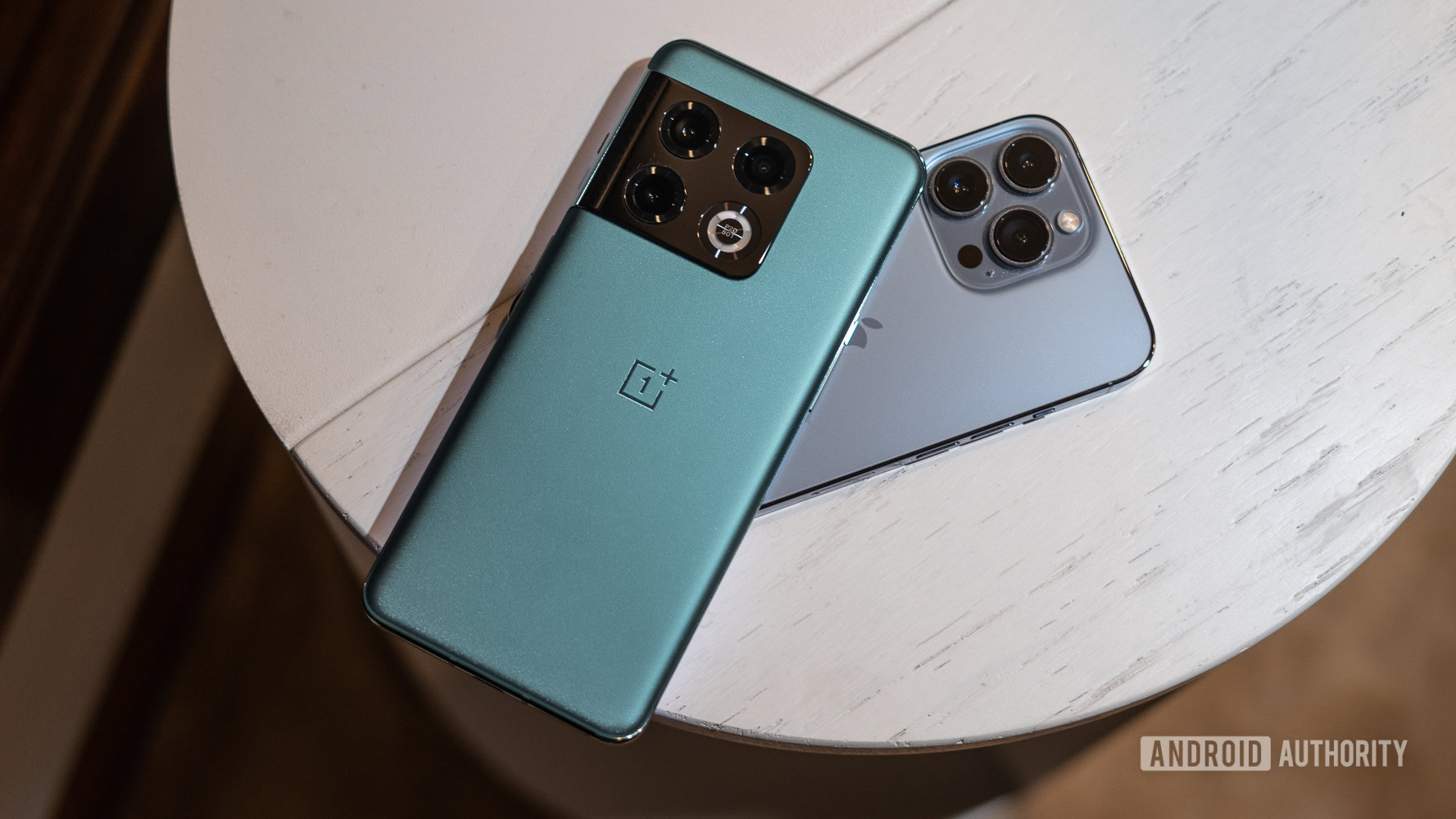
Each new flagship launch offers Android the chance to take on the best that iOS has to offer. Samsung started the year strong with its Galaxy S22 series, but now it’s time for OnePlus to have a go. The OnePlus 10 Pro reimagines the rear camera bump but offers the powerful internals you’d expect. Apple’s latest iPhone, on the other hand, makes a few key refinements to a successful formula. Does either one offer enough to make you switch operating systems? Let’s find out in this OnePlus 10 Pro vs iPhone 13 Pro comparison.
Our verdicts: OnePlus 10 Pro review | iPhone 13 Pro Max review
Before we start, a quick note to clarify that we’ll stick to the smaller iPhone 13 Pro for most of this comparison. You can splurge on the larger iPhone 13 Pro Max, but it generally offers the same specs with a larger display and higher price.
OnePlus 10 Pro vs iPhone 13 Pro
Design and display
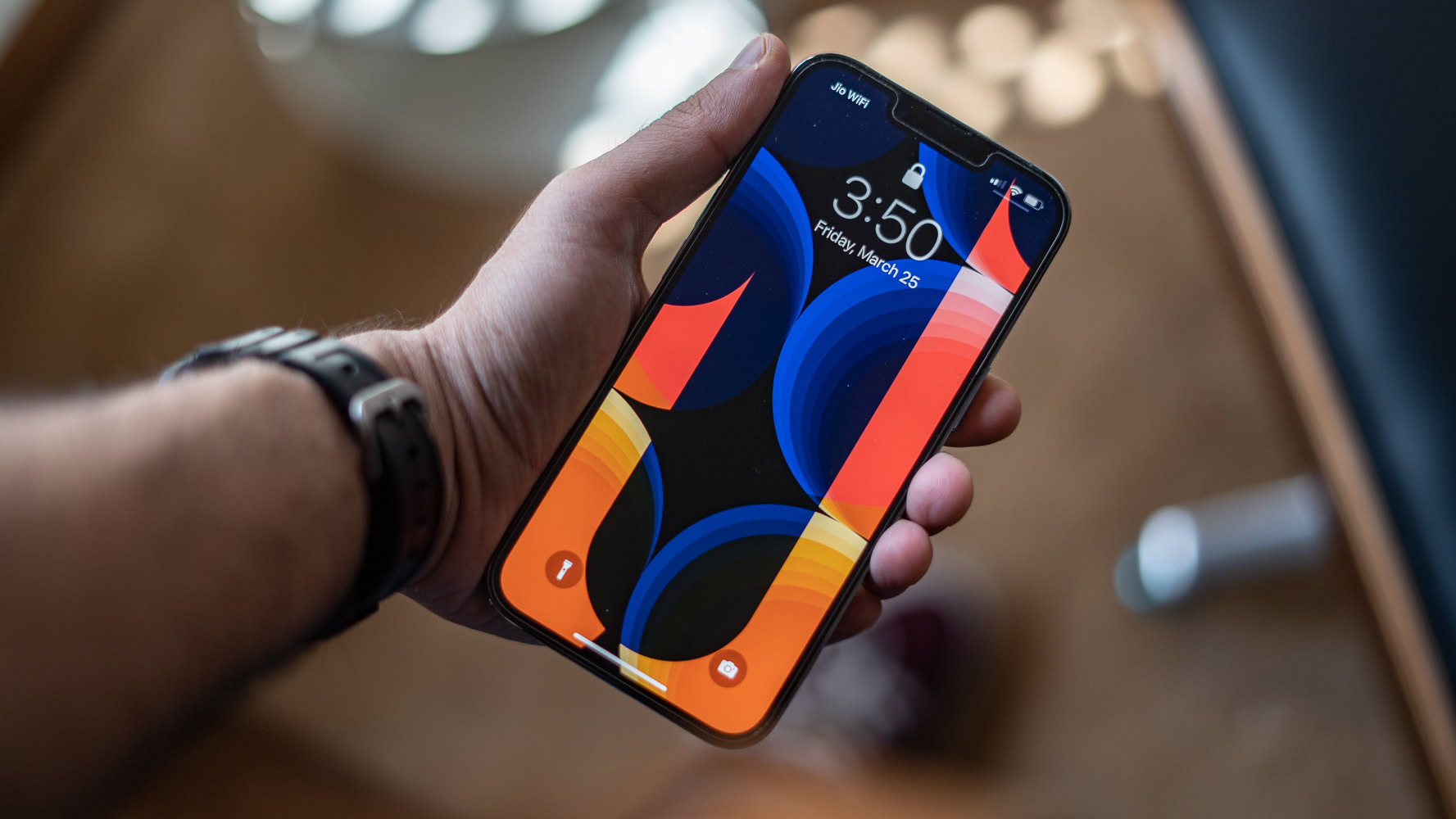
Apple’s iPhone 13 Pro design should feel familiar to current iOS users. It follows the same trends set by the iPhone 12 family but adds a few key refinements. The notch, for example, is about 20% smaller, though this doesn’t have an impact on the phone’s Face ID capabilities. The camera bump has grown by a few millimeters in all directions on the back, but the trio of cameras keeps the same layout.
You’ll also find that Apple’s satin glass finish is back for another year, which holds off fingerprints pretty well. The frame is made from stainless steel instead of the aluminum that you get with Apple’s more affordable flagships. As usual, the Lightning port sits along the bottom edge, the power button is on the phone’s right side, and the volume buttons and mute switch hold down the left side.
The iPhone 13 Pro doesn't reinvent the wheel, but it refines an already excellent formula.
The iPhone 13 Pro’s display is the same size as its predecessor, sitting at 6.1-inches. It’s now a Super Retina OLED panel, and it packs a smooth 120Hz refresh rate with Dolby Vision support. If the 6.1-inch panel isn’t large enough, you can also opt for the iPhone 13 Pro Max with its 6.7-inch panel. It offers the same refresh rate and display quality, just stretched to a larger form factor. Either way, you get a flat panel of Ceramic Shield glass that Apple boasts is tougher than ever before.
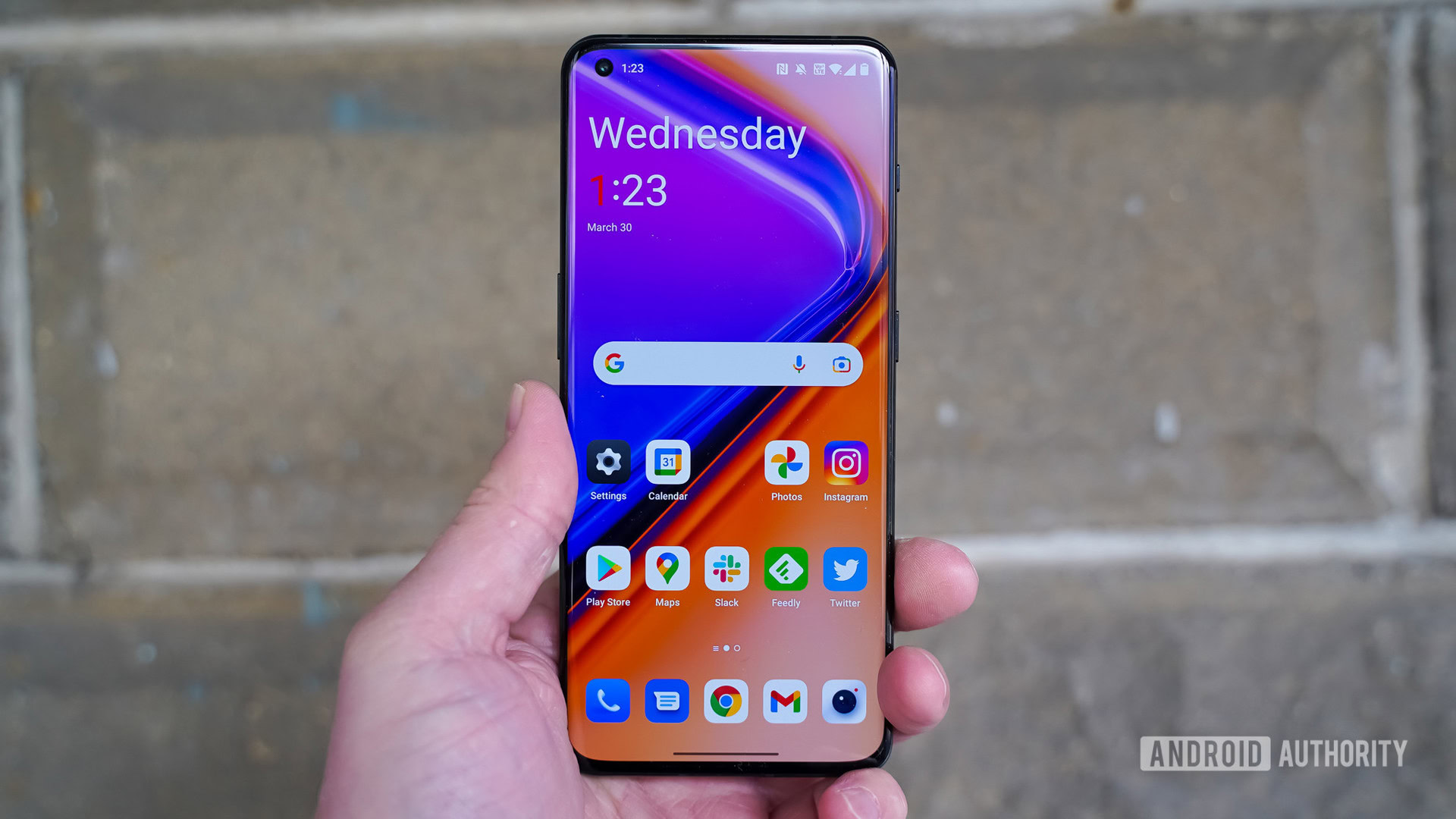
Over on the OnePlus 10 Pro, the camera bump offers the most significant change to the overall design. The OnePlus 9 Pro featured a fairly standard corner-mounted rear camera, but its successor shifts the lenses slightly lower. It also drops the monochrome lens, so now the camera bump packs three Hasselblad-tuned shooters and a large flash. The rest of the back panel is made from Gorilla Glass 5, a repeated material from the last generation. One unwelcome change, however, is the lack of an IP rating for water and dust resistance in all but the T-Mobile version. The iPhone 13 Pro is IP68 rated.
See also: Just how tough is Gorilla Glass?
If you were to hold the OnePlus 9 Pro and OnePlus 10 Pro in each hand, you might not know them apart. The 6.7-inch Fluid AMOLED display is exactly the same, right down to the waterfall edges and corner-mounted selfie camera. It’s a punch hole sensor, but it’s doubled in resolution from 16MP to 32MP. Otherwise, the display offers a 120Hz refresh rate, 1,300 nits of peak brightness, and a 20:9 aspect ratio.
Put up against the iPhone 13 Pro, the OnePlus 10 Pro offers plenty of extra real estate. The punch hole camera takes up less space than Apple’s notch, but the waterfall edges won’t be for everyone. The iPhone 13 Pro Max is a suitable alternative if you need more screen space, but you’ll pay handsomely for it.
Hardware and cameras
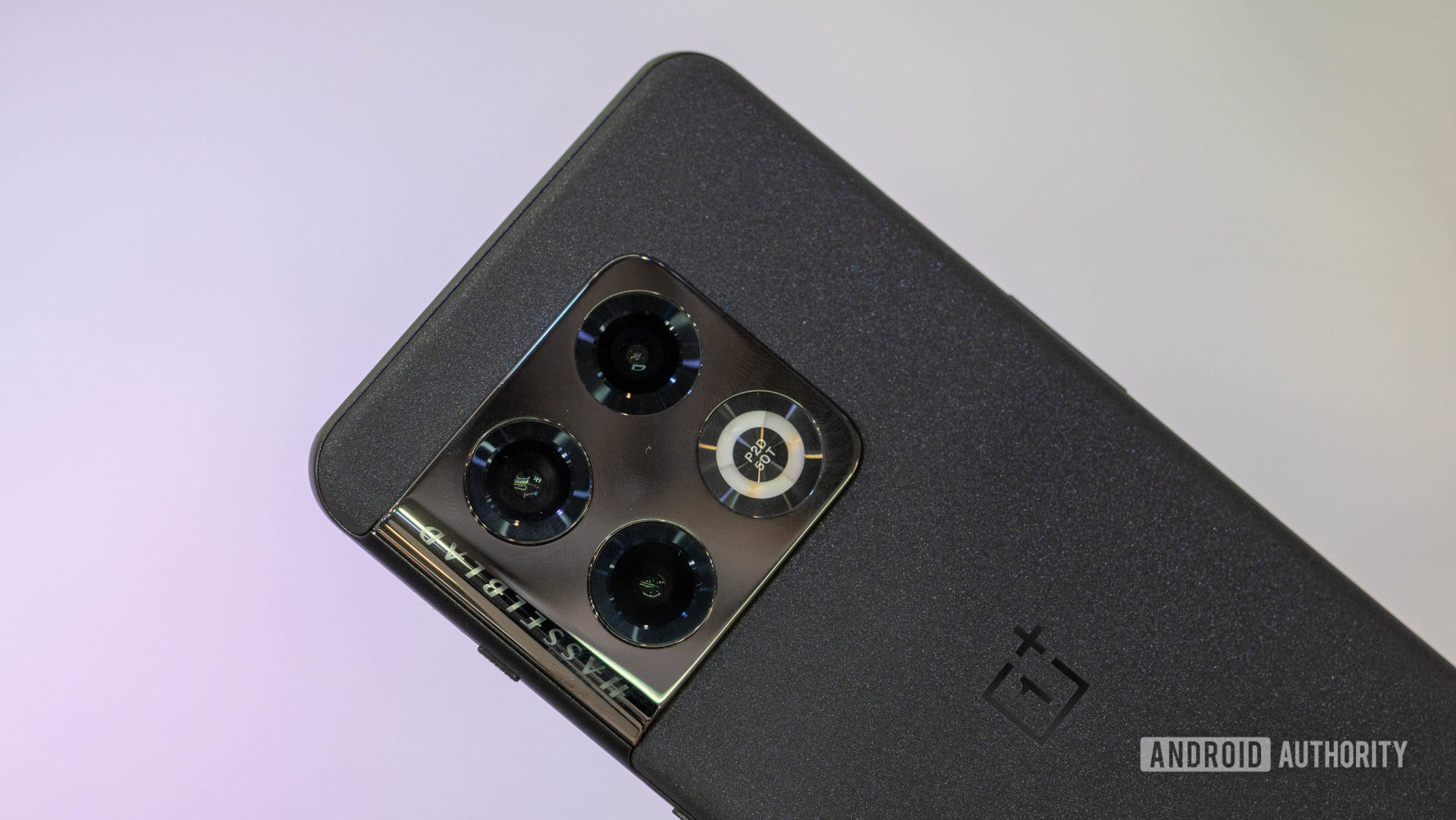
The only similarity between the OnePlus 10 Pro camera and the iPhone 13 Pro camera is the number of lenses you get. Both devices carry three shooters on the back and a fourth on the front, but the similarities end there. OnePlus opted for a custom 48MP primary lens from Sony, flanked by an 8MP telephoto lens and a brand-new ultrawide shooter. The ultrawide lens offers a 50MP resolution and a 150-degree field of view, though it’s set to 110-degrees by default. You can also check out a Fisheye mode if you want to feel like you’re in a 90’s rap video. As for video, the OnePlus 10 Pro can handle up to 8K at 24fps or 4K at 120fps.
See also: The best camera phones you can buy
On the other hand, Apple kept its 12MP triple threat for the iPhone 13 Pro and Pro Max. The wide, ultrawide, and telephoto lenses offer the same resolutions with a fourth 12MP option on the front. Don’t let the megapixels fool you — the iPhone 13 Pro cameras are great thanks to Apple’s processing capabilities. The real selling point for Apple’s cameras is the video capability. Cinematic mode is one of the best around, and it’s able to capture 4K footage at up to 60fps.
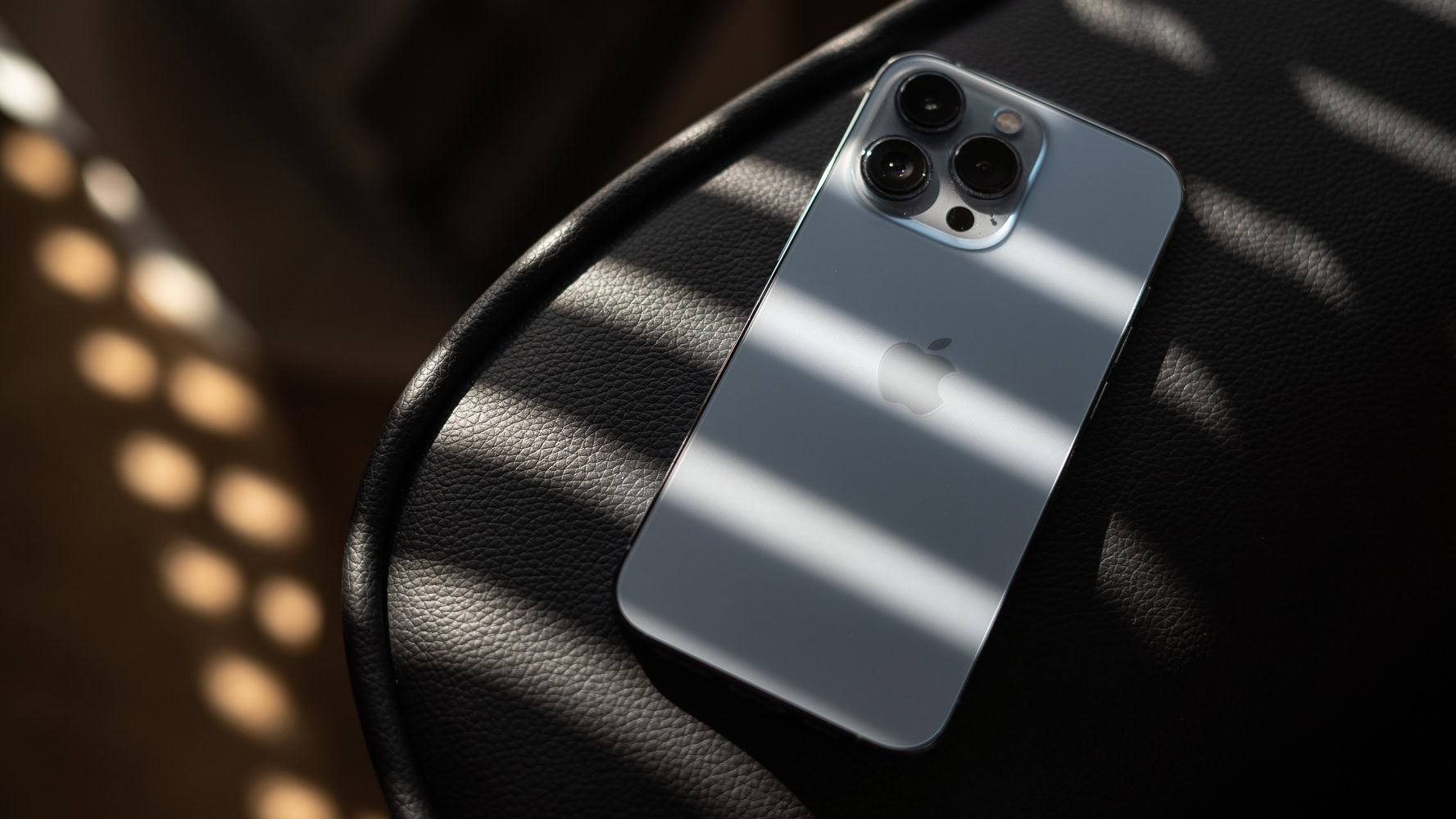
Once we move to hardware, the differences get even more noticeable. The iPhone 13 Pro runs on Apple’s in-house A15 Bionic processor paired with 6GB of RAM. It puts up benchmark numbers with the best of them, and the real-world performance in games and heavy-duty apps backs up the raw data. 128GB of storage is now the baseline, and you can upgrade as high as 1TB for an added cost.
The OnePlus 10 Pro relies on the latest Snapdragon 8 Gen 1 processor with 8GB of RAM to power you through daily tasks. It comes with 128GB of storage on the base model, but there’s a 12GB of RAM and 256GB storage version too (though it’s not available in the US at the time of this writing). Qualcomm’s flagship processor benchmarks well, too, though throttling due to heat has been an issue in almost every device we’ve tested.
Both phones pack high-end processors, but OnePlus is the king of batteries and charging.
OnePlus’ latest flagship holds an advantage in the battery and charging departments, no question. It packs a pair of 2,500mAh cells for a total capacity of 5,000mAh with blistering charging speeds. US users can tap into 65W wired speeds, while the rest of the world can enjoy 80W charging. Better yet, you still get a charging brick in the box. OnePlus didn’t skimp on wireless charging, either, with 50W wireless and 5W reverse wireless speeds.
Apple is far less forthcoming with its charging numbers, including the battery size. We know that the cell is larger than the one on the iPhone 12 Pro, somewhere around 3,000mAh. Despite the size, the phone also lasts a long time, likely due to Apple’s impressive optimization. You can tap into approximately 23W wired charging speeds, while MagSafe adds 15W wireless power. Using a Qi wireless pad, you’ll see closer to 7.5W charging speeds. There’s no charger in the box, however.
See also: The best charging accessories
Price and colors
- Apple iPhone 13 Pro (6/128GB): $999
- Apple iPhone 13 Pro (6/256GB): $1,099
- Apple iPhone 13 Pro (6/512GB): $1,299
- Apple iPhone 13 Pro (6/1TB): $1,499
- OnePlus 10 Pro (8/128GB): $899
- OnePlus 10 Pro (12GB/256GB): TBC
The OnePlus 10 Pro with 8GB of RAM and 128GB of storage is more affordable than any iPhone 13 Pro model and offers a price cut over its predecessor. It starts at $899, a discount of $70 on the OnePlus 9 Pro with a matching configuration. We don’t have confirmed pricing for the 12GB and 256GB version in the US yet, but it would be hard to see it surpassing the iPhone 13 Pro with the same storage.
Apple’s smaller Pro model kicks off at a cool $999 for 128GB of storage, with 256GB raising the price by $100, while the jumps to 512GB and 1TB cost an extra $200 each. If you decide you want the iPhone 13 Pro Max, you can add $100 to those prices, starting at $1,099.
Save some money: The best Apple iPhone deals | The best OnePlus deals
As for colors, OnePlus kept things pretty simple. You can choose from either Forest Green or Volcanic Black, both with a lightly textured finish. The Forest Green hue has a somewhat satin color, while the Volcanic Black is more matte. Apple followed its usual formula for the iPhone 13 Pro, with Silver and Gold options on launch day. You can also try Graphite, which is almost black, and Sierra Blue, which is lighter than the iPhone 12 Pro’s Pacific Blue. If you’ve waited patiently for your new iOS flagship, Apple added an Alpine Green to the mix after launch.
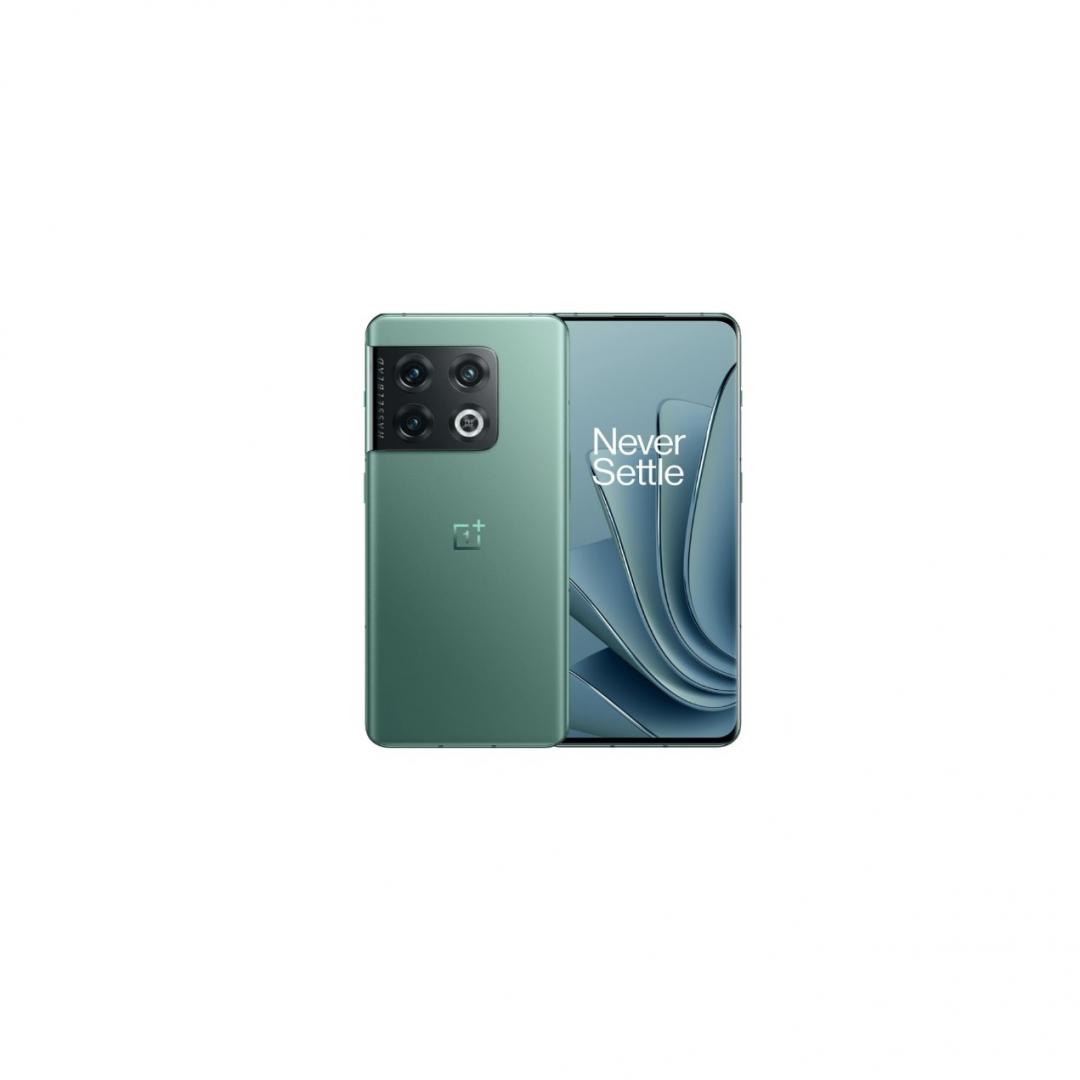
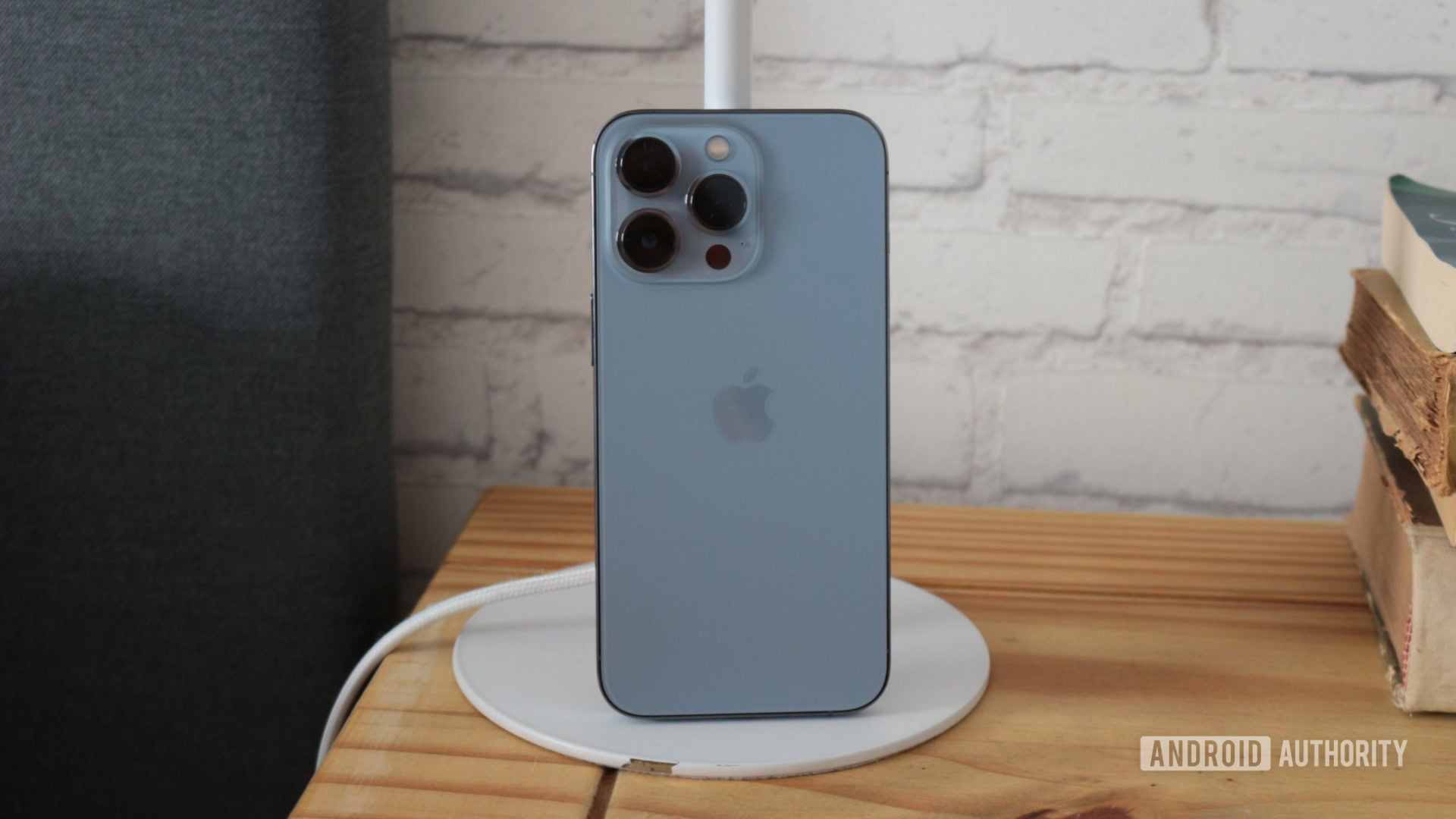
OnePlus 10 Pro vs iPhone 13 Pro: Specs
| OnePlus 10 Pro | Apple iPhone 13 Pro | |
|---|---|---|
Display | OnePlus 10 Pro 6.7-inch LTPO AMOLED 120Hz variable refresh rate QHD+ (1440p) resolution | Apple iPhone 13 Pro 6.1-inch Super Retina XDR OLED 2,532 x 1,170 resolution ProMotion 120Hz HDR, True Tone Wide color (P3) 2,000,000:1 contrast ratio 1,000 nits max brightness (typical); 1200 nits max brightness (HDR) Ceramic Shield front |
Processor | OnePlus 10 Pro Snapdragon 8 Gen 1 | Apple iPhone 13 Pro Apple A15 Bionic |
RAM | OnePlus 10 Pro Up to 12GB LPDDR5 | Apple iPhone 13 Pro 6GB |
Storage | OnePlus 10 Pro Up to 256GB UFS 3.1 No microSD card slot | Apple iPhone 13 Pro Up to 1TB No microSD card slot |
Power | OnePlus 10 Pro 5,000mAh battery 80W wired charging 50W wireless charging (with proprietary stand) 5W reverse wireless charging 65W charging brick in box in US (80W in other markets) | Apple iPhone 13 Pro Qi wireless charging up to 7.5W Up to 50% charge in around 30 minutes with 20W adapter or higher (sold separately) MagSafe: Wireless charging up to 15W Magnet array Alignment magnet Accessory Identification NFC Magnetometer |
Cameras | OnePlus 10 Pro Rear - 48MP wide - 50MP ultrawide, up to 150-degree FoV - 8MP telephoto 10-bit color capture on all lenses 12-bit RAW capture on all lenses Dual OIS on at least one lens Second-gen Hasselblad software Front: - 32MP | Apple iPhone 13 Pro Rear: -Wide-angle 12MP, ƒ/1.5, dual OIS, 7-element lens, 100% Focus Pixels, Night Mode -Ultra-wide 12MP, ƒ/1.8, 120° field of view, 5-element lens, lens correction, Night Mode -Telephoto 12MP, ƒ/2.8, dual OIS, 6-element lens 3x optical zoom in, 2x optical zoom out, 6x optical zoom range, digital zoom up to 15x, Deep Fusion, Smart HDR 3, Apple ProRAW Video: HDR video with Dolby Vision up to 60fps 4K video at 24fps, 30fps, or 60fps 1080p HD video at 30fps or 60fps 720p HD video at 30fps OIS for video (Wide) 3x optical zoom in, 2x optical zoom out; 6x optical zoom range, digital zoom up to 9x Front: -TrueDepth 12MP, ƒ/2.2 Night Mode, Deep Fusion, Smart HDR 3 |
Audio | OnePlus 10 Pro Dual stereo speakers No 3.5mm headphone port | Apple iPhone 13 Pro Dual stereo speakers No 3.5mm headphone port |
Connectivity | OnePlus 10 Pro Bluetooth 5.2 NFC support 5G support | Apple iPhone 13 Pro 5G (sub‑6GHz and mmWave) Gigabit LTE with 4x4 MIMO and LAA Wi‑Fi 6 (802.11ax) with 2x2 MIMO Bluetooth 5 Ultra Wideband chip for spatial awareness NFC Express Cards with power reserve GPS, GLONASS, Galileo, QZSS, and BeiDou Digital compass Wi‑Fi Cellular iBeacon microlocation |
Dimensions | OnePlus 10 Pro 163 x 73.9 x 8.55mm | Apple iPhone 13 Pro 146.7 x 71.5 x 7.65mm |
Software | OnePlus 10 Pro Oxygen OS 12 based on Android 12 China only: Color OS 12 based on Android 12 | Apple iPhone 13 Pro iOS 15 |
Colors | OnePlus 10 Pro Volcanic Black, Emerald Forest | Apple iPhone 13 Pro Graphite, Gold, Silver, Sierra Blue, and Alpine Green |
OnePlus 10 Pro vs iPhone 13 Pro: Which should you buy?
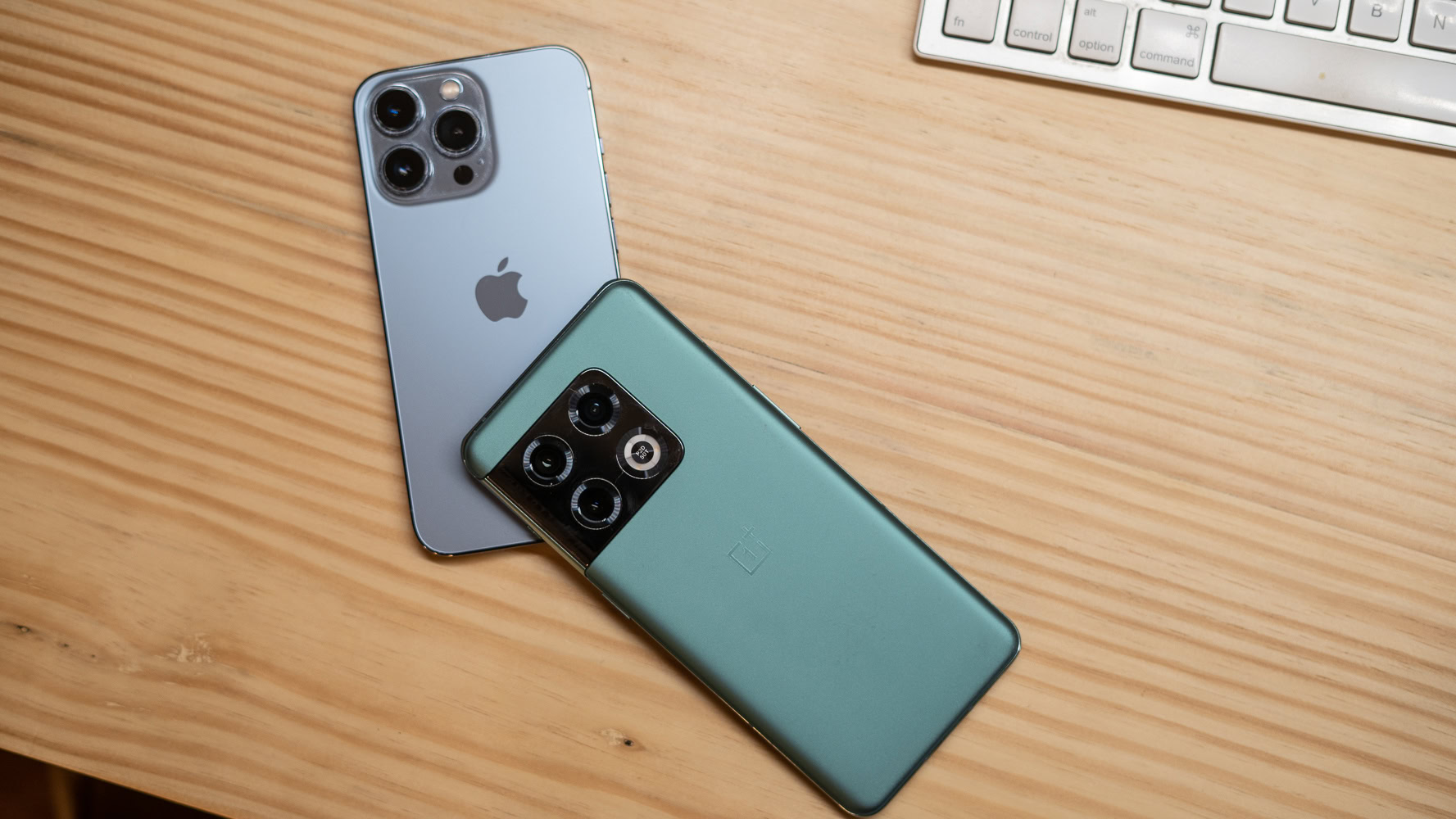
Choosing between Android and iOS rarely comes down to the spec sheet itself. Instead, your current ecosystem plays a significant role. If you already have the OnePlus Watch or a pair of OnePlus Buds, there’s a good chance you’ll want to stick with what you know. Apple Watch and iPad owners are probably in the same boat. However, the iPhone 13 Pro and the OnePlus 10 Pro have some features that could tempt you to swap sides.
It’s nearly impossible to top Apple’s software support, with older devices like the iPhone 7 still receiving full version updates. The iPhone 13 Pro doesn’t offer the most screen real estate, nor is it the most affordable, yet it integrates almost seamlessly with the entire Apple ecosystem. It packs up to 1TB of storage — four times what the OnePlus 10 Pro can offer. It’s also got a top-level camera system and a battery that keeps on going well into a second day on a single charge.
Both the iPhone 13 Pro and OnePlus 10 Pro offer premium experiences, but your current ecosystem will likely be the deciding factor.
On the other hand, the OnePlus 10 Pro is set up to go toe to toe with the best Android phones of the year. It offers more than enough screen real estate at 6.7-inches, and the Hasselblad-tuned camera delivers good results, though the ultrawide has proved to be a bit shaky in our testing and low light performance doesn’t impress.
OnePlus doesn’t hold a candle to Apple’s update commitment (OnePlus offers three years of upgrades and four years of security patches), but the 10 Pro boasts charging speeds far beyond the iPhone’s secretive levels. The OnePlus 10 Pro is also at least $100 more affordable than the iPhone 13 Pro, but we’ll have to wait for final pricing on the 12GB version.
Speaking of affordable, if you want to save a few dollars, you can also consider the regular iPhone 13 ($799). It drops the ultrawide and is limited to a 60Hz display, but it retains a lot of what makes the iPhone 13 Pro tick at a reduced price. On the other hand, if you want the biggest and best, the iPhone 13 Pro Max ($1,099) is the iPhone 13 Pro but bigger. What’s not to like?
Have you decided on your stance in the battle of the OnePlus 10 Pro vs iPhone 13 Pro? Let us know in the poll below.